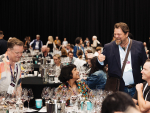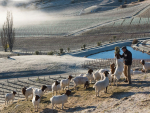A Thousand Gods
I like to think that when Simon Sharpe and Lauren Keenan heard they'd been named The Real Review Rising Star of the Year, they cried out "miladiou!"
A Kiwi start-up is harnessing enzyme technology to simplify nitrogen testing for winemakers, a critical factor in producing quality wines.
Co-founded by Dr Lee Ann Tejada, Dr Matthew Nicholson, and Professor Wayne Patrick, eNZyma is on the verge of advancing the wine industry with an innovative enzyme-based nitrogen test.
The idea was conceived over a glass of wine when Wayne, an enzymologist at Victoria University, was discussing the challenges of winemaking with friends. They expressed a need for a quick, efficient way to test for yeast assimilable nitrogen (YAN) – a key parameter in winemaking that influences fermentation quality and, ultimately, the taste of the wine. “Nitrogen is one of the essential elements yeast needs,” Matthew explains. “If you don’t have enough nitrogen in there, then your fermentation can’t go to completion. If you have too much, it can go too fast.”
The traditional methods of testing YAN are not only time-consuming and expensive but also present logistical challenges due to the seasonal nature of wine production. Matthew is the Senior Commercialisation Manager at Wellington UniVentures – the university’s technology transfer office. He explains that the current process involves sending samples to analytical laboratories, with each test costing around $60 and results taking up to 48 hours – a significant delay in a process where time is of the essence.
The team’s solution was an enzyme-based test resulting in a colour change, providing an approximation of the YAN levels in an hour at a fraction of the current cost. “It’s quick; it takes an hour and it gives you a result,” Matthew explains, adding that the team is “hoping we can put something on the market in the region of $5 a test instead of the $60”.
This innovation not only addresses the efficiency and cost concerns but also “democratises” the testing process, making it accessible even to smaller wineries without in-house testing capabilities. Envisioned to be “farmer-proof”, the test requires no special technical skills, making it an attractive tool for winemakers of all scales. “The test doesn’t require precise, technical expertise. You throw the things together, you give it a shake, and you compare it to a colour chart, and you know where you are,” Matthew explains. “So, the winemaker can do it. They will know if levels are too low or too high and they need to do something. But most of the time, it will give them the answer that they’re hoping for, which is that they are in the right zone. And they can just sleep well.”
eNZyma’s journey has been bolstered by collaborations, including invaluable input from the Sprout Accelerator programme. This engagement provided the team with mentorship, network access, and strategic business insights. The journey to productisation, however, has not been without challenges. Finding the right enzymes that could function effectively in the acidic environment of wine and ensuring their stability in a tablet form were significant hurdles.
Moreover, the team faced the classic start-up dilemma of balancing product refinement with the urgency to launch. However, they are now ready to take the leap into market introduction. The immediate goal is raising funds and launching the product, aiming to provide winemakers with a tool that allows rapid decision-making. Their business model revolves around partnering with existing distributors who already have a foothold in the wine industry, thereby leveraging established networks for market penetration.

The end of the year is fast approaching, so here are some thoughts on a few of the significant developments…

OPINION: When I moved to Marlborough two decades ago, I found countless lines of tidy vines, neatly mowed and carefully…
The large 2025 harvest will exacerbate the wine industry's "lingering" supply from recent vintages, New Zealand Winegrowers Chief Executive Philip…
If you find a new consumer in a developed wine market, you are taking them from someone else, says Blank…
OPINION: Sauvignon Blanc was famously introduced to New Zealand by Ross Spence of Matua Valley, and then serendipitously planted in…